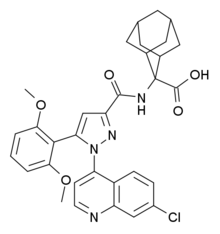SR-48692
 | |
| IUPAC ime | |
|---|---|
2-([1-(7-Chloro-4-quinolinyl)-5-(2,6-dimethoxyphenyl)-1H-pyrazole-3-carbonyl]amino)admantane-2-carboxylic acid | |
| Identifikatori | |
| CAS broj | 146362-70-1 |
| PubChem | CID 119192 |
| IUPHAR/BPS | 1582 |
| Hemijski podaci | |
| Formula | C32H31ClN4O5 |
| Molarna masa | 587.064 |
| |
SR-48692 je lek koji je selektivni, nepeptidni antagonist neurotenzinskog receptora NTS1. On je bio prvi nepeptidni antagonist razvijen za ovaj receptor.[1][2] SR-48692 se koristi u naučnim istraživanjima za izučavanje interakcija između neurotenzina i drugih neurotransmitera u mozgu.[3][4][5][6][7][8] On proizvodi anksiolitske, antiadiktivne i efekte ograničavanja memorije u životinjskim studijama.[9][10][11][12]
Reference[уреди | уреди извор]
- ^ Gully D, Canton M, Boigegrain R, Jeanjean F, Molimard JC, Poncelet M, Gueudet C, Heaulme M, Leyris R, Brouard A (1993). „Biochemical and pharmacological profile of a potent and selective nonpeptide antagonist of the neurotensin receptor”. Proceedings of the National Academy of Sciences of the United States of America. 90 (1): 65—9. PMC 45600
 . PMID 8380498. doi:10.1073/pnas.90.1.65.
. PMID 8380498. doi:10.1073/pnas.90.1.65.
- ^ Gully D, Jeanjean F, Poncelet M, Steinberg R, Soubrié P, Le Fur G, Maffrand JP (1995). „Neuropharmacological profile of non-peptide neurotensin antagonists”. Fundamental & Clinical Pharmacology. 9 (6): 513—21. PMID 8808171. doi:10.1111/j.1472-8206.1995.tb00528.x.
- ^ Rostene W, Azzi M, Boudin H, Lepee I, Souaze F, Mendez-Ubach M, Betancur C, Gully D (1997). „Use of nonpeptide antagonists to explore the physiological roles of neurotensin. Focus on brain neurotensin/dopamine interactions”. Annals of the New York Academy of Sciences. 814: 125—41. PMID 9160965.
- ^ Jolas T, Aghajanian GK (1997). „Neurotensin and the serotonergic system”. Progress in Neurobiology. 52 (6): 455—68. PMID 9316156. doi:10.1016/S0301-0082(97)00025-7.
- ^ Dobner PR, Deutch AY, Fadel J (2003). „Neurotensin: dual roles in psychostimulant and antipsychotic drug responses”. Life Sciences. 73 (6): 801—11. PMID 12801600. doi:10.1016/S0024-3205(03)00411-9.
- ^ Chen L, Yung KK, Yung WH (2006). „Neurotensin selectively facilitates glutamatergic transmission in globus pallidus”. Neuroscience. 141 (4): 1871—8. PMID 16814931. doi:10.1016/j.neuroscience.2006.05.049.
- ^ Petkova-Kirova P, Rakovska A, Della Corte L, Zaekova G, Radomirov R, Mayer A (2008). „Neurotensin modulation of acetylcholine, GABA, and aspartate release from rat prefrontal cortex studied in vivo with microdialysis”. Brain Research Bulletin. 77 (2-3): 129—35. PMID 18721670. doi:10.1016/j.brainresbull.2008.04.003.
- ^ Petkova-Kirova P, Rakovska A, Zaekova G, Ballini C, Corte LD, Radomirov R, Vágvölgyi A (2008). „Stimulation by neurotensin of dopamine and 5-hydroxytryptamine (5-HT) release from rat prefrontal cortex: possible role of NTR1 receptors in neuropsychiatric disorders”. Neurochemistry International. 53 (6-8): 355—61. PMID 18835308. doi:10.1016/j.neuint.2008.08.010.
- ^ Griebel G, Moindrot N, Aliaga C, Simiand J, Soubrié P (2001). „Characterization of the profile of neurokinin-2 and neurotensin receptor antagonists in the mouse defense test battery”. Neuroscience and Biobehavioral Reviews. 25 (7-8): 619—26. PMID 11801287. doi:10.1016/S0149-7634(01)00045-8.
- ^ Tirado-Santiago G, Lázaro-Muñoz G, Rodríguez-González V, Maldonado-Vlaar CS (2006). „Microinfusions of neurotensin antagonist SR 48692 within the nucleus accumbens core impair spatial learning in rats”. Behavioral Neuroscience. 120 (5): 1093—102. PMID 17014260. doi:10.1037/0735-7044.120.5.1093.
- ^ Felszeghy K, Espinosa JM, Scarna H, Bérod A, Rostène W, Pélaprat D (2007). „Neurotensin receptor antagonist administered during cocaine withdrawal decreases locomotor sensitization and conditioned place preference”. Neuropsychopharmacology : Official Publication of the American College of Neuropsychopharmacology. 32 (12): 2601—10. PMID 17356568. doi:10.1038/sj.npp.1301382.
- ^ Lévesque K, Lamarche C, Rompré PP (2008). „Evidence for a role of endogenous neurotensin in the development of sensitization to the locomotor stimulant effect of morphine”. European Journal of Pharmacology. 594 (1-3): 132—8. PMID 18706409. doi:10.1016/j.ejphar.2008.07.048.
Spoljašnje veze[уреди | уреди извор]
 | Molimo Vas, obratite pažnju na važno upozorenje u vezi sa temama iz oblasti medicine (zdravlja). |
